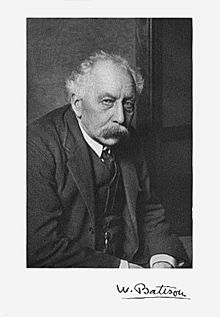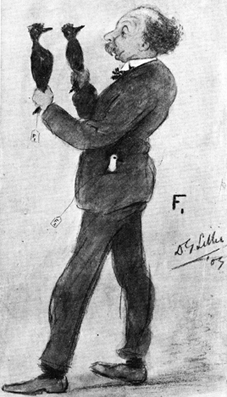William Bateson facts for kids
Quick facts for kids
William Bateson
|
|
|---|---|

William Bateson
|
|
| Born | 8 August 1861 Whitby, Yorkshire
|
| Died | 8 February 1926 (aged 64) |
| Nationality | British |
| Alma mater | St. John's College, Cambridge |
| Known for | heredity and biological inheritance |
| Awards | Royal Medal (1920) |
| Scientific career | |
| Fields | genetics |
William Bateson (1861–1926) was an English biologist. He was the first person to use the word "genetics". This word describes the study of how traits are passed down from parents to children. He also helped make the ideas of Gregor Mendel popular. Mendel's important work on heredity was rediscovered in 1900. Bateson's 1894 book, Materials for the Study of Variation, was an early book about genetics.
Contents
Early Life and Learning
William Bateson was born in 1861 in Whitby, England. His father was the Master of St John's College, Cambridge. William went to Rugby School and then to St John's College. He finished his studies in natural sciences in 1883.
He first studied embryology, which is about how living things develop. He traveled to the United States to study a worm-like animal called Balanoglossus. This work made him interested in how animals with backbones first appeared. He later returned to England and became a Fellow at St John's. He studied how living things vary and how traits are passed on. He even traveled in Central Asia for his research.
His Work in Science
Between 1900 and 1910, Bateson led a group of scientists at Cambridge. This group focused on genetics. Many of his helpers were women from Newnham College, Cambridge. This included his wife, Beatrice, and her sister, Florence Durham.
These women helped Bateson with his research. At that time, Mendel's ideas were not yet fully accepted. Scientists like Muriel Wheldale Onslow did many breeding experiments. They studied different plants and animals. Their results supported and added to Mendel's laws of heredity. Hilda Blanche Killby also helped Bateson. She repeated Mendel's pea experiments. She also did her own studies with rabbits and chickens.
In 1910, Bateson became the director of the John Innes Centre. This is a famous research center for plants. He moved his family to Merton Park. There, he became very interested in how chromosomes carry traits. He encouraged the study of cytology, which is the study of cells. He hired scientists like C. D. Darlington to help with this.
In 1919, he started The Genetics Society. This was one of the first groups dedicated to the study of genetics. He was the director of the John Innes Horticultural Institution until he passed away in 1926.
His Family Life
William Bateson was married to Beatrice Durham. They got married in June 1896. Their son was Gregory Bateson. Gregory later became a famous anthropologist.
Awards and Honors
In 1894, William Bateson became a Fellow of the Royal Society. This is a very important science group. He won their Darwin Medal in 1904. He also received the Royal Medal in 1920.
He was the president of the British Science Association from 1913 to 1914.
Studying Variation in Nature
Before 1900, Bateson studied how living things have different features. He looked at how these differences might explain evolution. He was inspired by Charles Darwin and Francis Galton. Darwin collected many examples of variation. Galton used numbers to study these differences.
Bateson noticed that some features do not change smoothly. For example, earwigs might have long or short pincers. There are not many in-between sizes. He called this "discontinuous" variation. He wondered if this type of variation could lead to new species.
In his 1894 book, Materials for the Study of Variation, Bateson explored this idea more. He showed that some traits vary smoothly, and others vary in clear steps. He named these "meristic" and "substantive" variations. He thought that traits that varied in steps could be changed more easily by evolution.
In this book, Bateson also described homeotic mutations. This is when one body part is replaced by another. For example, he studied bees with legs instead of antennae. He also looked at humans with extra fingers or ribs. These changes are caused by special genes called homeobox genes. These genes control how an animal's body forms when it is very young. Scientists won a Nobel Prize in 1995 for work on these genes. They are very important for how all animals develop.
Bateson wrote in his book that scientists needed to do breeding experiments. He believed this was the best way to understand how traits are passed down. He did not know that Gregor Mendel had already done such experiments many years before. Mendel had studied thousands of plants.
Bateson also came up with "Bateson's rule." This rule says that extra legs on an insect often look like mirror images of the normal legs.
In 1897, Bateson made more progress in studying variation. He said that sudden, clear changes might be very important for creating new species. He explained that "discontinuous variation" means that traits do not blend completely. Instead, the different forms stay separate. He started doing breeding experiments with a plant called Biscutella laevigata. He found that hairy and smooth forms of the plant did not blend when crossed. Their offspring were either hairy or smooth, not a mix. This showed that these traits did not blend together.
Around this time, Hugo de Vries and Carl Correns also started similar plant breeding experiments. They knew about Mendel's work, but Bateson did not. In 1899, Bateson gave a speech. He talked about his studies on discontinuous variation and his experiments. He encouraged other scientists to do large, well-planned breeding experiments. Just six months later, de Vries and Correns rediscovered Mendel's work.
Starting the Field of Genetics
Bateson became well-known for supporting Mendel's ideas. He disagreed with other scientists who believed in gradual changes in evolution. Later, scientists like Ronald Fisher showed that sudden changes (mutations) could still lead to gradual evolution. This helped create the modern understanding of evolution.
Bateson first suggested the word "genetics" in a letter in 1905. The word comes from a Greek word meaning "to give birth." He first used the term publicly in 1906 at a science conference. Bateson and Edith Saunders also created the word "allelomorph." This word was later shortened to "allele". An allele is a different form of a gene.
Bateson also helped discover genetic linkage with Reginald Punnett and Edith Saunders. This is when genes located close together on a chromosome are often inherited together. Bateson and Punnett started the Journal of Genetics in 1910. Bateson also created the term "epistasis". This describes when one gene affects how another gene is expressed.
The John Innes Centre holds a special lecture each year called the Bateson Lecture. It honors his important contributions to science.
Images for kids
See also
 In Spanish: William Bateson para niños
In Spanish: William Bateson para niños




